new posts in all blogs
Viewing: Blog Posts Tagged with: carl sagan, Most Recent at Top [Help]
Results 1 - 9 of 9
How to use this Page
You are viewing the most recent posts tagged with the words: carl sagan in the JacketFlap blog reader. What is a tag? Think of a tag as a keyword or category label. Tags can both help you find posts on JacketFlap.com as well as provide an easy way for you to "remember" and classify posts for later recall. Try adding a tag yourself by clicking "Add a tag" below a post's header. Scroll down through the list of Recent Posts in the left column and click on a post title that sounds interesting. You can view all posts from a specific blog by clicking the Blog name in the right column, or you can click a 'More Posts from this Blog' link in any individual post.

By: Shelf-employed,
on 2/13/2015
Blog:
Shelf-employed
(
Login to Add to MyJacketFlap)
JacketFlap tags:
space,
scientists,
astronomy,
picture books for older readers,
bio,
E,
STEM,
Carl Sagan,
STEM Friday,
book review,
science,
Add a tag
Sisson, Stephanie Roth. 2014. Star Stuff: Carl Sagan and the mysteries of the cosmos. New York: Roaring Brook.
In simple text augmented by word bubbles, thought bubbles, and sketches, Stephanie Roth Sisson gives us the highlights of Carl Sagan's life
—but more importantly, she offers a sense of his wondrous enthusiasm for the cosmos,
It gave Carl goose bumps to think about what he had learned about the stars, planets, and the beginnings of life. He wanted everyone to understand so that they could feel like a part of the stars as he did.
So he went on television.
This is the first book that Stephanie Roth Sisson has both written and illustrated. The fact that she is enthralled with her subject is apparent in the artwork. Painted cartoon images (often in panels with word bubbles), depict a happy Sagan, wide-eyed and curious. While some pages are like panel comics, others are full-bleed, double spreads depicting the vastness of the darkened skies, dotted by planets or stars. One foldout opens vertically, reminding us of our infinitesimal existence in the cosmos. We are so small, yet we are reminded,
The Earth and every living thing are made of star stuff.
Star Stuff is a 2015
NCTE Orbis Pictus Award Honor book for "outstanding nonfiction for children."
Substantial back matter includes Author's Note, Notes, Bibliography and Sources, Special Thanks, and Source Notes.
Preview the first eight pages of Star Stuff on the publisher's website.Note: Carl Sagan graduated from Rahway High School in Rahway, NJ. As far as I can tell, he's not mentioned anywhere on the school's website. Pity.
It's STEM Friday! (STEM is Science, Technology, Engineering, and Mathematics)

.jpeg?picon=3324)
By: Keith Mansfield,
on 11/15/2014
Blog:
Keith Mansfield
(
Login to Add to MyJacketFlap)
JacketFlap tags:
Film,
Science,
space,
Aliens,
Cinema,
Carl Sagan,
Brian Cox,
bfi,
Adam Rutherford,
Add a tag
As part of their brilliant science fiction season, last night BFI Southbank saw a special screening of Contact, a movie based on the novel by SETI pioneer, Carl Sagan.
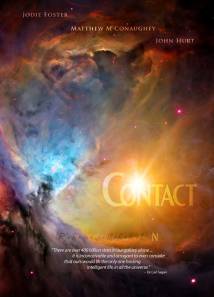 It’s not a short film, but no one in the packed audience minded that the Q&A preceding it, with Professor Brian Cox and Dr Adam Rutherford, took over an hour. Huge credit to my former employers, the British Film Institute, for not making it token, but giving us the chance for a meaty discussion on what many think is the most important question facing science: where is everybody?
It’s not a short film, but no one in the packed audience minded that the Q&A preceding it, with Professor Brian Cox and Dr Adam Rutherford, took over an hour. Huge credit to my former employers, the British Film Institute, for not making it token, but giving us the chance for a meaty discussion on what many think is the most important question facing science: where is everybody?
This was the question posed to colleagues over lunch one day (in 1950) by physicist Enrico Fermi. It has become known as the “Fermi paradox”. The “everybody” in question are aliens … extraterrestrials.
Why should we care?
Many people think the fundamental moment in the history of Western science was when Copernicus said Earth orbited the Sun rather than the other way around. This wasn’t simply a convenient coordinate shift. It was saying Earth is not the centre of the Universe. We inhabit just one of many planets. We have no privileged position in the cosmos. We are ordinary. The same “laws of nature” that apply on and around Earth apply equally in the rest of the Universe. This has become known as the “Copernican principle” and it is the foundation of scientific thought.
We have a problem. Look out at night – look further through our telescopes (and we can look so very far) and the Universe is vast. There are hundreds of billions of galaxies, like our own Milky Way. Just within ours, there are maybe 400 billion stars, most with planets. Conservative estimates, as Brian Cox told the audience (these are based on Kepler findings) hold that one in ten stars will have habitable planets in orbits that allow liquid water on their surface.
Further, at 4.5 billion years, Earth and our solar system are relatively young. The Milky War is far, far older. inally, mathematical models show it’s perfectly possible to colonize the entire galaxy in a brief time – say, 10 million years. Yet when we look skywards, we see not the slightest evidence if any intelligence in the entire Universe, other than what we find here on Earth. This suggests we are very special indeed – the polar opposite to the fundamental principle of science.

The Arecibo message
Sagan pondered this question long and hard. In his early, pioneering days of SETI, they were actively trying to communicate with extraterrestrials and before the movie, Cox and Rutherford were sitting in front of a radio message intentionally broadcast to the stars.
Sagan also helped designed messages added to the Voyager deep space probes (Voyager 1 is now over 18 light hours away, carrying a gold record with sounds of Earth and a map of how to find its inhabitants). Since those heady days, we think more about “existential risk” – things that potentially threated our survival as a species. One such risk is contact with alien races, so we’ve become more circumspect.
Looking back, I think the novel, Contact, was important for me as both a writer and publisher. I loved the story. It combined so many elements that I’m passionate about and, foolishly at the time I thought I could have told it better! Of course that’s not true, but I would nowadays have been a good editor for Sagan, had he let me. It certainly made me realize I was capable of being a good storyteller, and my current work-in-progress is a novel that revisits this same territory. I find it unfathomable now that I asked Sagan to sign my copy of Cosmos, which he kindly did, but not my copy of Contact – what was I thinking?
The film’s good, but there’s so much more in the book that anyone who likes the movie would get a lot from reading the novel. It was commented that Contact is a little overlooked as a science fiction film. Very true, but with my screenwriting hat on I think that’s because there’s so much to cram in, the narrative is very linear and straightforward. And Sagan’s thoughtful climax may have been unsatistfactory for mainstream audiences used to a different style of alien encounter.
In the movie, scientist Ellie Arroway (played by Jodie Foster and the character Cox and Rutherford said was the best depiction of a scientist on screen) detects a message from aliens, using radio telescopes. This was how Sagan and fellow SETI pioneer Frank Drake expected our first contact with extraterrestrials would go, and the film describes how things might unfold after receipt – the message is written in mathematics, the only universal language. There’s still an old-school SETI community working in this area, but increasingly scientists are thinking of alternative ways to identify evidence of aliens, often in the form of (very) large scale engineering projects such as Dyson spheres or matter-antimatter burners. We’re still looking.
If you’ve not seen the movie, you really should. Here’s the trailer to whet your appetite:
It’s part of the BFI’s excellent Sci-Fi: Days of Fear and Wonder season.



By: James Preller,
on 1/24/2013
Blog:
James Preller's Blog
(
Login to Add to MyJacketFlap)
JacketFlap tags:
Family,
James Preller,
Bill Nye,
Carl Sagan,
Around the Web,
In the Classroom,
Maggie Preller,
Overheard Preller,
Middle School Life,
I Fucking Love Science,
Wheel of wonder,
Add a tag
Lisa had asked Maggie, grade 6, about her classes and received the above reply. Which at first struck me as a hilarious thing to say about science. It was like saying, I don’t know, math should funnier.

But then I realized she might be onto something. When we think of our science teachers, most of them are dry, dull, strict. This is science, this is important: this is serious business!
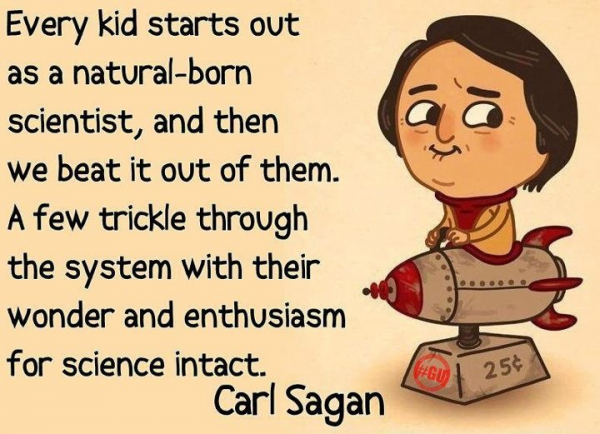
And in fairness, it often is, kids can get hurt, things might explode.

But then there are those rare science teachers — and scientists like Bill Nye, on television — who bring the joy of discovery into the process. Or should I say, keep the joy. The wonder.

They find the fun and the funny. Like a child with a new toy, figuring out what makes it go. Discovering the awesomeness of it all.
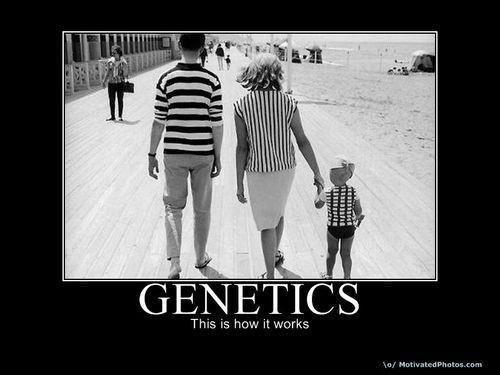
On Facebook I “liked” a site called, “I Love F***ing Science.” I’ve always regretted the F***ing in that title because it makes it harder for me to share with others, especially anyone who might read my books.

This post reflects a few things I’ve picked up from there, and other places.
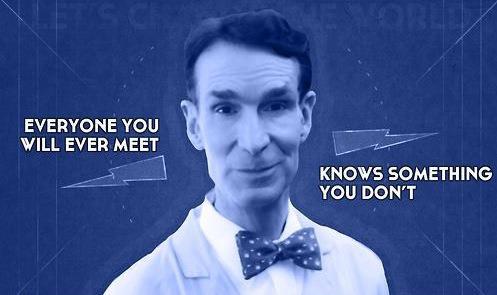
Just trying to bring the fun, Maggie. I’m glad you like science.
.jpeg?picon=3323)
By: Keith Mansfield,
on 8/5/2012
Blog:
JohnnyMackintosh.com
(
Login to Add to MyJacketFlap)
JacketFlap tags:
Book news,
History,
Science,
Doctor Who,
Space,
Viking,
NASA,
Ray Bradbury,
JPL,
Steven Moffat,
arnold schwarzenegger,
David Bowie,
Carl Sagan,
Total Recall,
Battle for Earth,
John Carter,
Len Wiseman,
The Martian Chronicles,
Edgar Rice Burrows,
Mars Curiosity,
Mars Sojourner,
opportunity rover,
spirit rover,
Add a tag
This morning at 6.31 am (British Summer Time), Johnny and Clara Mackintosh (and their Old English sheepdog, Bentley) made history: thanks to NASA and its Mars Curiosity rover, they became the first literary heroes to literally land on another world. And all broadcast live in Times Square – wow!

Johnny, Clara and Bentley, lowered to the Martian surface on the back of Curiosity (courtesy JPL)
The descent was scary (I wrote a piece about it for Bookzone4Boys) – even NASA had described it as “seven minutes of terror”. Eventually the Mars Science Laboratory landed by “skycrane” in Gale Crater, a perfect location to examine millions of years of Martian geology in one go. Onboard was a microchip onto which had been etched the names of some of the people of Earth, the very first ambassadors to land on another planet. And among those names were:
- Johnny Mackintosh
- Clara Mackintosh
- Bentley Mackintosh
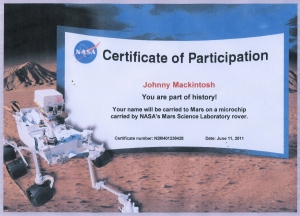
I confess I’m delighted to say “Keith Mansfield” was also included. 
Some great fictional stories have been set on Mars, but the paper or celluloid that tells them remains firmly grounded here on our island Earth. John Carter may have disappointed in cinemas lately, but Edgar Rice Burroughs’ series of “Barsoom” books are classics. A film that brought the red planet properly to life saw the now-Governator of California star as Doug Quaid in Dutch director Paul Verhoeven’s 1990 masterpiece, Total Recall. Why anyone feels the need to remake a movie that was originally so stunning is a mystery, but I’ll reserve judgement until I’ve seen Len Wiseman’s remake.
As a child I grew up reading the late, great Ray Bradbury, whose thoughtful Martian Chronicles helped inspire the stories I’ve written. In the first two Johnny Mackintosh books there are mentions of Mars and Johnny and Clara always intend to go there, yet somehow they never quite get round to it. In Battle for Earth they finally make the trip (I won’t spoil it for future readers by saying whether or not they find Martians).
David Bowie famously sang “Is there life on Mars?” and in a fun Doctor Who tribute, Steven Moffat christened the first fictional human settlement “Bowie Base One”. I’ve written a few pieces on whether or not there’s life of some kind on the red planet over at my Keith Mansfield website.
We’ve always found Martian exploration difficult. On page 3 of Johnny Mackintosh: Battle for Earth we read:
“Johnny and Clara had been planing their first ever visit to Mars, with Johnny telling his sister about all the probes scientists had sent to the red planet, but which had mysteriously failed to arrive.”
and then, a little later on page 61:
“Early space probes had taken intriguing but inconclusive photographs of the Martian surface, showing what were called the Pyramids of Elysium, next to what appeared to be a gigantic human face gazing upward. Johnny had always meant to visit and see for himself. For his part, Alf was curious to hear about the probes that had gone missing, so Johnny repeated the conversation he’d had with Clara, in a little more detail. Given the great expense of space exploration, the failure rate for Mars was unusually high. It wasn’t only Beagle 2 that had bitten the dust as it neared the planet. Over the years, around half the missions launched had failed for one reason or another.”
Of course the “giant face” is no more than an optical illusion, but sometimes you can’t let details like that get in the way of a good story. I first came across the pyramids through Carl Sagan’s Cosmos and these don’t only feature in Johnny Mackintosh – Total Recall also centred around the mysterious “pyramid mine”.
Nowadays we know a huge amount about this near neighbour, not least because there are actually three satellites in permanent orbit around the red planet. In the 1970s we sent the twin Viking landers to search for life (you can see a third in the Smithsonain Air and Space Museum in Washington DC). These tantalized, but also frustrated. Given the track record of previous Mars missions, this one played it relatively safe so the spacecraft set down in what proved rather dull areas – and that’s where they remained. The great thing about Curiosity is that it’s mobile.
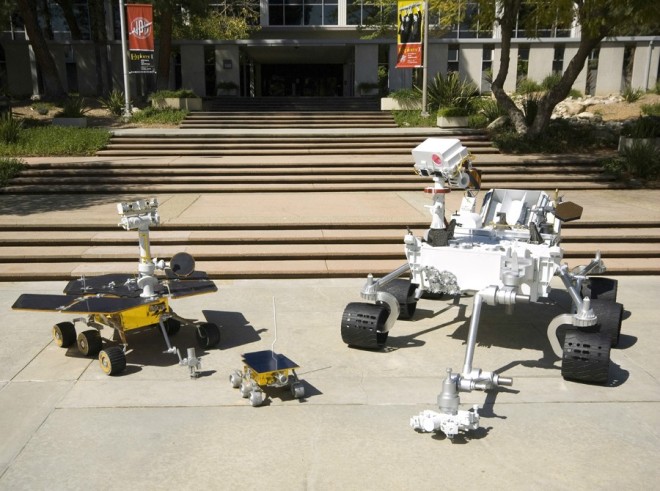
Mars rover family portrait showing Sojourner, one of Spirit/Opportunity and then Curiosity (courtesy NASA)
We’ve come a long way in a short space of time with Mars rovers. The first was Sojourner, a little add on to the Pathfinder mission that landed in 1997. It was the size of a remote-controlled child’s toy and could only travel a few metres from the main landing station, getting up close and personal with a few interesting nearby rocks. Sojourner started the ball rolling, and the momentum was magnificently maintained by another pair of twin landers, the Mars Exploration Rovers Spirit and Opportunity, which set down early in 2004.
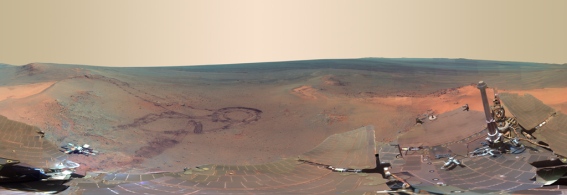
Mars panorama using composite images from Opportunity, showing the rover’s own tyre tracks (courtesy NASA)
Larger, more independent and mobile, it was hoped these two would function for around 90 days. Spirit lasted fully five years, becoming immobile on 2009 and finally ceasing communication in 2010. Opportunity is still going! These two have shown that we are more than capable, not just of landing on Mars, but traversing its surface.
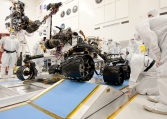
Curiosity being put through its paces on Earth (courtesy of JPL)
Curiosity is in a different league altogether. Weighing nearly a tonne, it’s around the size of a small car. It doesn’t move quite as fast, travelling at what’s almost literally a snail’s pace, but wherever it goes, Johnny, Clara and Bentley will go with it. I hope they and I are able to move across the surface of this faraway world for many years to come.
Buy the first book in the series, Johnny Mackintosh and the Spirit of London.
 Buy the third book in the series, Johnny Mackintosh: Battle for Earth in which Johnny and Clara visit Mars.
Buy the third book in the series, Johnny Mackintosh: Battle for Earth in which Johnny and Clara visit Mars.


 |
| This is a teaser... The rest of the comic is at popsmoothie.com |
My latest
Pop Smoothie web comic: What will
Cosmos be like with
Seth MacFarlane at the helm?
http://popsmoothie.com/2012/07/09/cosmos-by-seth/
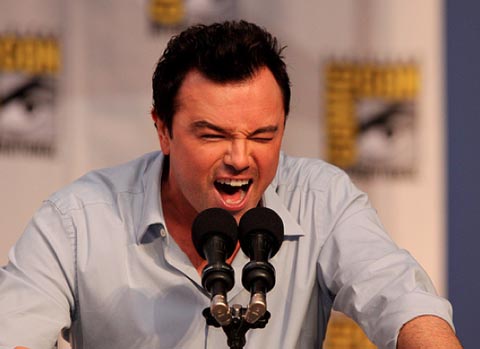
Seth MacFarlane, who has made a career of creating nuanced and thoughtful animated programs that broaden the horizons of viewers, is lending his expertise to the scientific community. He’s teaming up with Carl Sagan’s widow and astrophysicists Steven Soter and Neil deGrasse Tyson to create a sequel to the milestone science series Cosmos.
The new series, Cosmos: A Space-Time Odyssey, is “the story of how human beings began to comprehend the laws of nature and find our place in space and time,” according to the press release:
By exploring never-before-told stories of the heroic quest for knowledge, the series will take viewers to other worlds and travel across the universe for a vision of the cosmos on the grandest scale. The most profound scientific concepts will be presented with stunning clarity, uniting skepticism and wonder, and weaving rigorous science with the emotional and spiritual into a transcendent experience.
The thirteen-part series will debut on that bastion of scientific inquiry, FOX, beginning in 2013. Between this and his reboot of The Flintstones, there’s seemingly nothing that MacFarlane can’t do. Perhaps someday he’ll surprise everyone by actually doing something well.
(Photo credit: Gage Skidmore’s Flickr)
Cartoon Brew: Leading the Animation Conversation |
Permalink |
No comment |
Post tags: Carl Sagan, Seth MacFarlane

It has been a real Carl Sagan week here at MCFC headquarters. Hail Sagan!

By: Kirsty,
on 3/11/2011
Blog:
OUPblog
(
Login to Add to MyJacketFlap)
JacketFlap tags:
leona lewis,
mankini,
dovegreyreader,
nsew,
spaderman,
football,
Blogs,
facebook,
london,
inspirational,
sxsw,
divorce,
Leisure,
cracked,
carl sagan,
international women's day,
leona,
linked up,
*Featured,
londonist,
world book night,
Add a tag
For the 100th International Women’s Day this week, The Guardian chose their Top 100 inspirational women living today from a range of backgrounds and subjects. This is possibly the only time you’ll see Lady Gaga and Margaret Thatcher in the same list. [The Guardian]
A football (soccer) player was sent off the pitch this week after tackling a pitch intruder wearing a mankini. There’s video. [BBC News]
Bootlegged toys: yes, you too can own ‘Spaderman’. [Cracked.com]
One man’s experience of being a giver on World Book Night. [The Bookseller]
Two-thirds of lawyers said Facebook was the ‘primary source’ of evidence in divorce proceedings. [Shiny Shiny]
British book blogger extraordinaire Dovegreyreader celebrated the fifth birthday of her blog. [Dovegreyreader Scribbles]
If you can’t get to SXSW, perhaps you might be interested in NSEW. [Londonist]
Leona Lewis is London’s most influential woman? Really? [The First Post]
A guide to T A office hours. [PHD Comics]
‘If membership is restricted to men, the lose will be ours.’ [Letters of Note]
And finally… Daniel Craig in a dress for International Women’s Day:
Click here to view the embedded video.

.jpeg?picon=3324)
By: Keith Mansfield,
on 3/18/2010
Blog:
Keith Mansfield
(
Login to Add to MyJacketFlap)
JacketFlap tags:
Star Blaze,
Public appearances,
Oxford Science Festival,
science oxford,
supernova,
Chandrasekhar,
time machines,
Science,
Book signings,
space,
Sun,
time travel,
stars,
large hadron collider,
Carl Sagan,
Add a tag


























